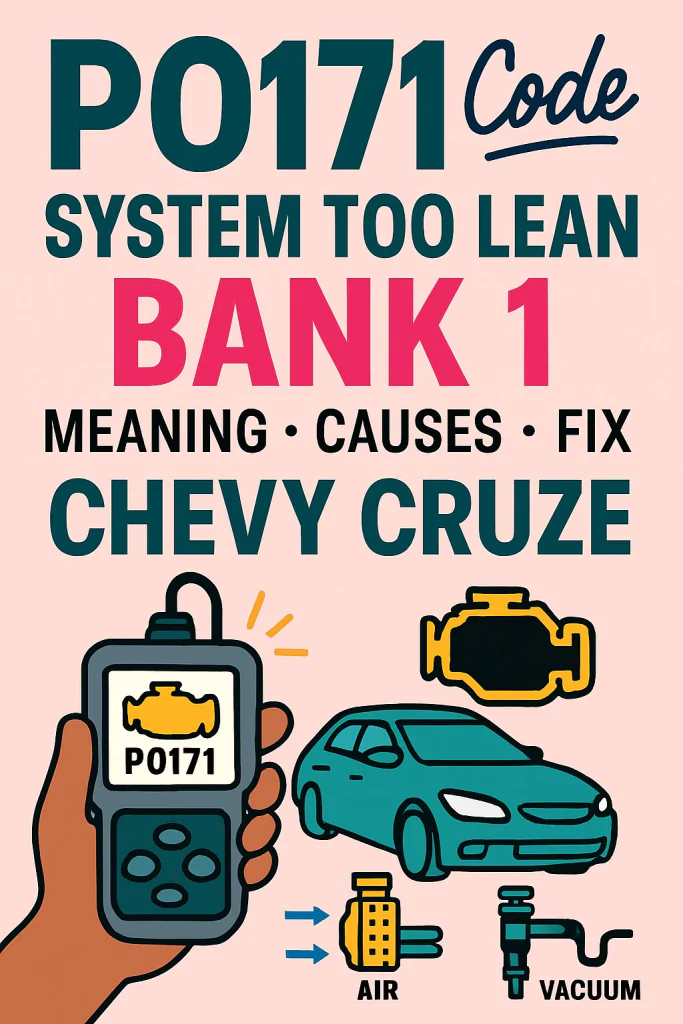P0171 Code (System Too Lean Bank 1): Meaning, Causes and Fix

When That Dreaded Code Pops Up
You’re driving along, enjoying the ride, when suddenly that little orange check engine light flickers to life. If you’ve scanned your car and discovered the P0171 code, your first thought is probably, “What the heck is a System Too Lean Bank 1?” Don’t worry, you’re not alone—I remember staring at this code on my own OBD-II scanner and thinking it sounded way more complicated than it really was.
The good news? While the P0171 code can feel intimidating, it’s often caused by issues that are completely fixable without a second mortgage. The key is understanding what it means, why it’s happening, and how to knock it out before it snowballs into something worse. Let’s dive in, friend-to-friend, and figure this out together.
What Does the P0171 Code Mean?
The P0171 trouble code translates to “System Too Lean (Bank 1).” Sounds technical, right? Here’s the plain-English version:
- System Too Lean = Your engine is getting too much air and not enough fuel in its combustion mixture.
- Bank 1 = The side of the engine that contains cylinder #1. (For inline 4-cylinder engines, which many daily drivers have, there’s only one bank, but the computer still calls it Bank 1.)
So basically, the car’s engine control module (ECM) noticed that the air/fuel mixture wasn’t balanced. When the oxygen sensors detect excess oxygen in the exhaust, the computer sets this code.
Why is This a Big Deal?
Engines are happiest when they run at the ideal 14.7:1 air-to-fuel ratio. When that balance goes lean, the engine may misfire, run rough, or even overheat. Long-term, ignoring this code could mean damaged pistons, valves, or catalytic converters. Nobody wants that bill.
Common Symptoms of P0171
Wondering how to spot this issue beyond the code itself? Here’s what most drivers notice:
- Check Engine Light is on (the obvious one).
- Rough idle—the car shakes or feels unstable at low RPMs.
- Weak acceleration—pressing the gas pedal doesn’t give the power you expect.
- Reduced fuel economy—yep, ironic since the engine is technically “lean.”
- Whistling or hissing noises—a dead giveaway of a vacuum leak.
- Occasional misfires or even engine stalling in worse cases.
Have you ever felt like your car suddenly lost its pep? Chances are, this code is one of the culprits.
What Causes the P0171 Code?
Here’s where things get interesting. P0171 can stem from a handful of issues. Let’s break them down.
1. Vacuum Leaks
Air sneaking into the engine without being measured by sensors is the #1 suspect. This happens from:
- Cracked or disconnected vacuum hoses
- Leaky intake manifold gasket
- PCV (positive crankcase ventilation) valve failures
2. Mass Air Flow (MAF) Sensor Problems
The MAF sensor measures how much air enters the engine. If it’s dirty or faulty, it sends incorrect info, and the computer thinks the mix is too lean.
3. Faulty Oxygen Sensors
Your upstream O2 sensor monitors oxygen in the exhaust stream. A failing one can falsely report lean conditions.
4. Fuel Delivery Issues
If the engine isn’t getting enough fuel, it runs lean by default. Common culprits include:
- Weak fuel pump
- Clogged fuel filter
- Dirty or restricted fuel injectors
5. Exhaust Leaks
A small crack in the exhaust manifold or pipe before the O2 sensor can trick the sensor into seeing too much oxygen.
👉 FYI: In many modern vehicles, vacuum leaks and dirty MAF sensors are the most common causes of P0171.
How to Diagnose P0171 Like a Pro (or at Least Like a Smart DIYer)
You don’t need to be a master mechanic to hunt this down. A simple step-by-step approach can save you hundreds.
Step 1: Scan for Codes
- Use an OBD-II scanner.
- Confirm it’s only P0171, or check if other codes like P0101, P0174, or P0300 show up too. These extra codes often point you toward the problem area.
Step 2: Inspect for Vacuum Leaks
- Pop the hood and check all hoses. Any cracks, loose clamps, or disconnected lines? That’s a red flag.
- Listen for a hissing sound with the engine running—it often means air is sneaking in.
Step 3: Check the MAF Sensor
- Look for dirt or oil residue. If you see gunk, that’s likely your issue.
- Carefully remove and spray with MAF sensor cleaner (never use carb or brake cleaner—it’ll destroy it).
Step 4: Test Fuel Pressure
- Hook up a fuel pressure gauge to the rail.
- Compare your reading to factory specs (usually 50–60 PSI for many vehicles, but check your manual).
Step 5: Inspect O2 Sensors
- If everything else checks out, a failing upstream O2 sensor might be sending false data.
DIY Fixes for P0171
Okay, so you’ve diagnosed the issue—now what? Here are the most common fixes you can try at home.
Clean the MAF Sensor
- Remove it carefully.
- Spray with MAF sensor cleaner.
- Let it air dry fully before reinstalling.
- Reset the code and test drive.
Replace the PCV Valve
If you hear whistling noises or see oil around the valve cover, the PCV valve diaphragm may be torn. This is a cheap and common fix.
Replace or Repair Vacuum Hoses
- Swap out cracked hoses.
- Re-secure loose clamps.
- Double-check connections near the throttle body and intake.
Swap the Intake Manifold Gasket
If a smoke test reveals leaks, replacing the gasket can restore balance. It’s more involved but very doable for weekend mechanics.
Fuel System Repairs
- Replace a clogged fuel filter.
- Add a fuel injector cleaner to your tank.
- If pressure is too low, the fuel pump may need replacement.
Oxygen Sensor Replacement
Still no luck? The upstream O2 sensor may need to go. A fresh sensor can quickly restore proper readings.
Repair Costs: DIY vs. Shop
Nobody likes surprise bills, so here’s what you might spend:
- MAF cleaning: $10 DIY, $80–$120 shop
- Vacuum hose replacement: $20–$100 DIY, $150–$250 shop
- PCV valve: $30–$60 DIY, $150–$200 shop
- Fuel pump: $150–$300 DIY, $600–$900 shop
- O2 sensor: $70–$120 DIY, $200–$350 shop
As you can see, many of these are affordable fixes if you’re willing to get your hands a little dirty.
Can You Still Drive with P0171?
Here’s the short answer: yes, but it’s not wise for long. Driving lean can cause:
- Engine overheating
- Knocking or pre-ignition
- Long-term damage to pistons, valves, or catalytic converters
So while your car won’t blow up tomorrow, you’re better off addressing it sooner rather than later.
How to Prevent P0171 from Coming Back
Once you’ve fixed it, keep these tips in mind to avoid seeing that code again:
- Use quality fuel—cheap gas can clog injectors.
- Replace the air filter regularly.
- Inspect hoses during oil changes for cracks or wear.
- Clean the MAF sensor every 15–20k miles.
A little preventative care goes a long way.
Conclusion: P0171 Isn’t the End of the World
So, what did we learn? The P0171 code (System Too Lean Bank 1) basically means your engine’s getting too much air and not enough fuel. The usual suspects? Vacuum leaks, dirty MAF sensors, or fuel delivery issues. Fixing it can be as simple as cleaning a sensor or swapping a hose, though sometimes it calls for bigger repairs like a fuel pump or O2 sensor.
Bottom line? Don’t panic. This code is common, it’s manageable, and with a bit of DIY spirit (and maybe a $10 can of cleaner), you can often handle it yourself. Think of your car’s check engine light as a text message, not a death sentence. 😉 Next time it pops up with P0171, you’ll know exactly what to do—and you’ll be back on the road with confidence.

![Can A Disconnected Muffler Throw A Check Engine Code [Answered]](https://automotiveglory.com/wp-content/uploads/2024/05/can-a-disconnected-muffler-throw-a-check-engine-code-answered_6152-768x529.jpg)




